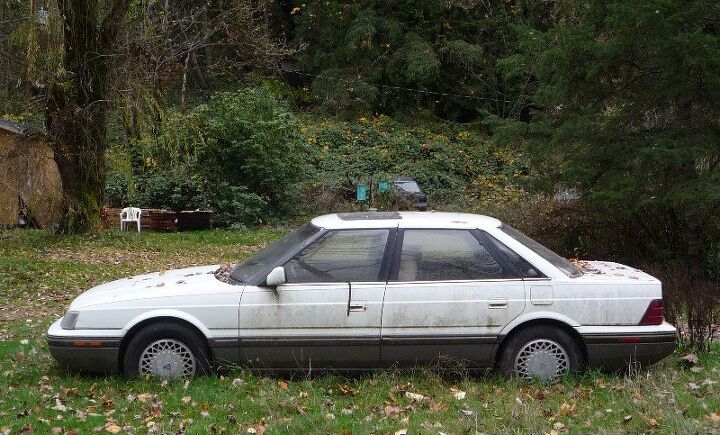Curbside Classic Dead Brands Week: 1987 Sterling 825 SL (Rover 825i)

N.B. In anticipation of Saab’s (inevitable) demise, we’re going to have Dead Brands Week at CC.
We’ll start off Dead Brands Week with a royal Rover triple bang, with this Sterling zombie corpse. When it comes to persistence (idiocy) in trying to flog dead corpses in the US, Rover absolutely takes the cake. It took three US deaths to finally convince Britain’s favorite maker of cars (and its government medium-wigs) to give up the ghost. The last attempt, Sterling, is the classic English car disaster story. Despite Rover’s intentions to avoid the usual pitfalls, by building an essentially reskinned Honda/Acura Legend, they still managed to create the ultimate rolling clap-trap English nightmare.
Let’s quickly recap Rover’s two previous deaths. Its complex and fiendishly unreliable 2000/3500 models of the sixties were overly ambitious, and collapsed around 1971. Rover exited the US market for almost ten years, but then spent a fortune certifying the SD-1 (3500) for the US market. In what will go down in history as one of the most spectacular failures ever, Rover managed to sell only 800 of the Ferarri Daytona-inspired fastback sedans, beginning in 1980. You would think that the scars from that flogging would be enough to keep them from ever trying again, but let’s not forget, this was now the government-backed British Leyland. Risk analysis is different when the feds are your backstop.
As an already dying entity, Rover wisely hooked up with Honda in a major alliance at the beginning of the eighties. Essentially, Rover handed new-product development over to Honda, and opened up its creaking production facilities for Honda’s European models in exchange. The development of an SD-1 executive sedan replacement was high on the list of priorities, and work started in 1981. Essentially, the Rover 800 series development was piggy-backed unto Honda’s new V6 Legend. Both the Rover and Legend were to be built in Rover’s historic ex-Morris plant in Cowley. An inauspicious beginning, building a new world-class car in the same plant that cobbled together the infamous Morris Marina and other BLMC shit boxes of the seventies and sixties.
The European Rover was called the 800 series, with various-numbered versions depending on the engine. Four cylinders were more common there, but the Rover four was not a Honda unit, rather a development of the BL O-series engine. The 2.5 liter V6 was a Honda, and the main version imported to the US. The Europeans (and a few late-model US cars) later got a 2.7 liter V6 and a VM-Motori diesel engine. In Europe, the Sterling moniker was a top trim level of the notch back sedans; there was also a hatchback, primarily for Europe, whose top trim level was the Vitesse.
Because of the highly acidic aftertaste the name Rover left in the US, it decided to call its 800 import Sterling. It was a reasonably handsome boxy sedan, in the typical idiom of the times. It’s main claim to fame was its luxurious English leather and wood interior; much warmer than the corresponding Legend and the antiseptic German imports. I’m sure the mushrooms are thriving in this one, on all that organic material. Sure enough, most US buyers had no clue this was a Rover, and initial sales were fairly encouraging.
But the 800 was born pre-mature. It suffered from a variety of serious maladies that its Japanese-built Legend was utterly devoid of. Build quality in general was shaky, and trim, electrics and paint quality, along with other gremlins quickly turned out to be highly Roverish. And I almost forgot: rust. The genuine 100% British variety. It all rapidly escalated into a crisis of epic proportions, and furious buyers watched their resale values plummet. Sterling was exposed for what it was, and within a couple of years, Sterling jokes were as almost as common as Yugo jokes. There’s a sucker born in every income class.
I was shocked when one of my tv station sales managers showed up with a new Sterling in 1987. The other one had just bought a a new Jaguar a few months before. I learned a lesson: sales people are often the biggest suckers for others’ sales pitches. I guess its just a way to show you truly believe in the religion of sales-speak. I was driving a W124 300E, and I remember way too many trips in it to pick them up at the Jaguar/Sterling dealer in San Jose. Both cars were utter nightmares; but the Sterling well outdid the Jag, if that’s possible. They were lovely cars to sit in; you just had to use your imagination about them actually moving.
Rover went on to patch up the 800 series for domestic consumption, and it underwent one face lift and a re-skin, and plodded along until 1999, when the BMW-designed Rover 75 finally put it down. Sales were primarily to government hacks, where the tradition of riding in Rovers if you didn’t merit a Jag or Daimler date back to the fifties. I haven’t seen a Sterling in ages, but here it sits, in a side yard of a house along the banks of the beautiful McKenzie River; a lovely genuine British lawn ornament.

More by Paul Niedermeyer
Latest Car Reviews
Read moreLatest Product Reviews
Read moreRecent Comments
- MaintenanceCosts E34 535i may be, for my money, the most desirable BMW ever built. (It's either it or the E34 M5.) Skeptical of these mods but they might be worth undoing.
- Arthur Dailey What a load of cow patties from fat cat politicians, swilling at the trough of their rich backers. Business is all for `free markets` when it benefits them. But are very quick to hold their hands out for government tax credits, tax breaks or government contracts. And business executives are unwilling to limit their power over their workers. Business executives are trained to `divide and conquer` by pitting workers against each other for raises or promotions. As for the fat cat politicians what about legislating a living wage, so workers don't have to worry about holding down multiple jobs or begging for raises? And what about actually criminally charging those who hire people who are not legally illegible to work? Remember that it is business interests who regularly lobby for greater immigration. If you are a good and fair employer, your workers will never feel the need to speak to a union. And if you are not a good employer, then hopefully 'you get the union that you deserve'.
- 28-Cars-Later Finally, something possibly maybe worth buying.
- EBFlex The simple fact is very small and cheap ICE vehicles have a range thats longer than all EVs. That is the bar that needs met. And EVs cannot meet that.Of course range matters. But that's one element of many that make EVs completely ineffective at replacing ICE vehicles.
- Wolfwagen I like the exterior mods short of the satellite dish. Put a normal interior in it and they could have sold it as some sci-fi movie trim







































Comments
Join the conversation
As a former owner of not one, but two Sterlings (both purchased used), I think your assessment is a tad harsh. Used, a two year old Sterling sold for just half of a comparable Acura/Honda Legend with which it shared a very well-regarded engine and drivetrain. The suspension was a Rover/Acura hybrid that my mechanic once described as a nightmare. The interiors of my two vehicles were rather nice and well put together. The Bosch(?) electrics of the first two model years sold in the US were horrible. The Lucas(?) electrics of my two later model Sterlings were fine. Both of my vehicles started to wear out at about 125k miles, so I dumped them. Their Honda/Acura cousins were a bit more durable. Bottom line, their Acura part was excellent and their Rover part only so-so. Now, in a business sense, the Rover 825/827 US foray was a well-deserved disaster. Rover itself was a dead man walking even in the UK. Its collaboration with Honda just delayed the inevitable.
I don't know if I'm right or not, but I have the impression that British Leyland was mismanaged at the top, and sabotaged by indifferent workers at the bottom. I also recall reading that one Socialist cabinet Minister was quoted as saying, "British Leyland's job is to provide jobs, not to build cars". If this is true, then I guess all is explained. I'd like to hear from any readers who have insight into British industry practices in the '60s,--- '90s.